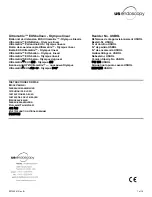
00732541 Rev. B
2 of 16
Not made with natural rubber latex.
Intended Use:
The US Endoscopy
Ultramatrix™ EUS balloon is intended to be used for endoscopic ultrasound applications using the balloon method in the upper or
lower gastrointestinal tract.
Warnings and Precautions:
•
Consult the medical literature relative to techniques, complications and hazards prior to the performance of any EUS procedure.
•
Inspect the balloon prior to use to ensure it has no holes, swelling, color changes or other irregularities. If an irregularity is detected,
DO NOT USE
THE BALLOON
. Obtain another balloon and
contact your local Product Specialist.
•
The balloon can easily tear, so beware of sharp objects.
•
Do not apply excessive force to or bend the distal end of the echoendoscope. Instrument damage may occur.
•
Do not feed water into the balloon when the water level in the water container is too low. The balloon may not inflate properly.
•
Do not disconnect the water container from the endoscope just after removing air bubbles from the balloon. This may cause the air bubbles to re-
enter the balloon when attempting to inflate the balloon again.
•
If using a thread to secure balloon, use caution to prevent occlusion of the balloon water supply/suctions ports of the echoendoscope.
•
The EUS Balloon may burst or come unseated if inflated to a diameter greater than the recommended 20 mm.
•
If balloon doesn’t deflate for echoendoscope extubation, and removal, please see directions below.
•
Do not attempt to reuse, reprocess, refurbish, remanufacture or resterilize this device. US Endoscopy did not design this device nor is it intended to
be reused, reprocessed, refurbished, remanufactured, or resterilized. Performing such activities on this disposable medical device presents a safety
risk to patients (i.e. compromised device integrity, cross-contamination, infection).
•
EUS procedures should only be performed by persons that have adequate training and familiarity with EUS techniques.
Contraindications:
•
Contraindications include those specific to any endoscopic procedure, as well as those specific to endoscopic ultrasound procedures.
Directions for Use:
1.
Prior to clinical use, familiarize yourself with the device and read all the Instructions for Use.
Section 1 - Attaching the balloon:
Applying balloon with Olympus balloon applicator (MAJ-675):
1.
Prime balloon water supply channel by means recommended by echoendoscope manufacturer.
2.
Stretch balloon three times by gently pulling the two ends of the balloon apart and allowing them to retract.
3.
Insert front end of balloon into applicator and stretch the rear band of the balloon and insert it into the attachment groove.
4.
Insert the distal tip of the echoendoscope into the balloon (and applicator) as far as possible.
5.
Roll the rear band off the applicator groove and into the balloon attachment groove of the echoendoscope.
6.
Adjust the rear band of the balloon so that it is completely seated within the balloon attachment groove circumferentially.
7.
If using a thread to secure balloon, tie it within the attachment groove of the echoendoscope.
Applying the balloon without applicator:
1.
Follow instructions one and two from section above discussing the use of the applicator for balloon attachment.
2.
Stretch open the rear band of the balloon slightly to allow for placement onto transducer tip.
3.
Insert the distal end of the echoendoscope further into the balloon by alternately stretching and pulling balloon proximally.
4.
Release the rear band of balloon into the balloon attachment groove of the echoendoscope.
5.
Adjust the rear band of the balloon so that it is completely seated within the balloon attachment groove circumferentially.
6.
If using a thread to secure balloon tie it tightly within the attachment groove of the echoendoscope.
Section 2 - Priming the balloon and expelling air:
1.
With the end of the insertion tube pointed down, depress the air/water valve completely and fill the balloon with de-aerated water.
2.
Inflate to approximately 20 mm in diameter.
3.
Confirm that there are no air bubbles within the balloon and depress the suction valve completely to remove all water from balloon.
4.
If air bubbles are present in the balloon, repeat steps 1 through 3 until all the air bubbles are completely aspirated.
5.
Now the balloon is ready to use.
Section 3 - Removing balloon from echoendoscope:
1.
While watching ultrasound image, deflate balloon by pressing down on the suction button completely and aspirating all of the water.
a.
If balloon doesn’t deflate proceed with the following steps:
i. Turn airflow/CO2 regulator off.
ii. Remove the air/water valve from the echoendoscope.
iii.
Lower control head of echoendoscope below patient’s bed.
iv. Visualize balloon deflation on ultrasound screen.
v. Replace air/water valve.
2.
Completely depress suction valve while removing echoendoscope from patient.
3.
After removing echoendoscope from the patient, carefully detach balloon from transducer.
Product Disposal:
After use, this product may be a potential biohazard. Handle and dispose of in accordance with accepted medical practice and applicable local,
state and federal laws and regulations.
Issued Date: February 2018
Warning:
An issued or revision date for these instructions is included for the user's information. In the event two years has elapsed between this date and product
use, the user should contact
US Endoscopy
to determine if additional information is available.
Liste
ning…and delivering solutions
®
, the US Endoscopy listening…and delivering solutions design, and all marks denoted with
®
or ™ are registered
with the U.S. Patent and Trademark Office, or trademarks owned by US Endoscopy
US Endoscopy, a wholly owned subsidiary of STERIS Corporation.
Olympus®
is a registered trademark of Olympus Optical Co., Ltd.
Made in the U.S.A
















